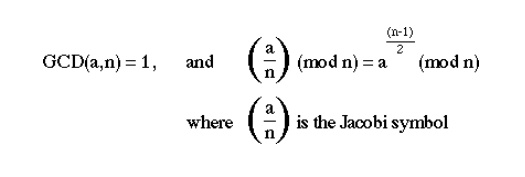Chapter: Cryptography and Network Security
Introduction to Number Theory
INTRODUCTION TO NUMBER THEORY
1 Primality Testing and RSA
The first
stage of key-generation for RSA involves finding two large primes p, q
Because
of the size of numbers used, must find primes by trial and error
Modern
primality tests utilize properties of primes eg:
an-1
= 1 mod n where GCD(a,n)=1
all
primes numbers 'n' will satisfy this equation
some composite numbers will also satisfy the equation, and are called
pseudo-primes.
Most
modern tests guess at a prime number 'n', then take a large number (eg 100) of
numbers 'a', and apply this test to each. If it fails the number is composite,
otherwise it is is probably prime.
There are
a number of stronger tests which will accept fewer composites as prime than the
above test. eg:

RSA Implementation in Practice
Software
implementations
generally
perform at 1-10 bits/second on block sizes of 256-512 bits
two main types of implementations:
- on micros as part of a key exchange mechanism in
a hybrid scheme
- on larger machines as components of a secure mail
system
Harware
Implementations
generally perform 100-10000 bits/sec on blocks sizes of 256-512 bits
all known
implementations are large bit length conventional ALU units
2 Euler Totient Function
[[phi]](n)
if
consider arithmetic modulo n, then a reduced
set of residues is a subset of the complete set of residues modulo n which
are relatively prime to n
eg for
n=10,
the
complete set of residues is {0,1,2,3,4,5,6,7,8,9} o the reduced set of residues is {1,3,7,9}
the number of elements in the reduced set of residues is called the Euler Totient function [[phi]](n)
there is
no single formula for [[phi]](n) but for various cases count how many elements
are excluded:
p (p prime) [[phi]](p) =p-1
pr (p prime) [[phi]](p)
=pr-1(p-1)
p.q (p,q prime) [[phi]](p.q)
=(p-1)(q-1)
several
important results based on [[phi]](n) are:
Theorem (Euler's Generalization)
let
gcd(a,n)=1 then
a[[phi]](n) mod n = 1
Fermat's
Theorem
let p be a prime and gcd(a,p)=1 then
ap-1 mod p = 1
Algorithms
to find Inverses a-1 mod
n
search
1,...,n-1 until an a-1 is found with a.a-1 mod n
if
[[phi]](n) is known, then from Euler's Generalization
a-1 = a[[phi]](n)-1 mod n
3. otherwise use Extended
Euclid's algorithm for inverse
3 Computing with Polynomials in
GF(qn)
have seen
arithmetic modulo a prime number GF(p)
also can
do arithmetic modulo q over polynomials of degree n, which also form a Galois
Field GF(qn)
its
elements are polynomials of degree (n-1) or lower
a(x)=an-1xn-1+an-2xn-2+...+a1x+a0
have
residues for polynomials just as for integers
p(x)=q(x)d(x)+r(x)
and this is unique if deg[r(x)]<deg[d(x)]
if
r(x)=0, then d(x) divides p(x), or
is a factor of p(x)
addition
in GF(qn) just involves summing equivalent terms in the polynomial
modulo q (XOR if q=2)
a(x)+b(x)=(an-1+bn-1)xn-1+...+(a1+b1)x+(a0+b0)
Multiplication with Polynomials in GF(qn)
multiplication
in GF(qn) involves
multiplying
the two polynomials together (cf longhand multiplication; here use shifts &
XORs if q=2)
then finding the residue modulo a given irreducible polynomial of degree n
an irreducible polynomial d(x) is a
'prime' polynomial, it has no polynomial divisors other than itself and 1
modulo
reduction of p(x) consists of finding some r(x) st: p(x)=q(x)d(x)+r(x)
nb. in GF(2n) with d(x)=x3+x+1 can do simply by
replacing x3 with x+1
eg in
GF(23) there are 8 elements:
0, 1, x, x+1, x2, x2+1, x2+x, x2+x+1
with
irreducible polynomial d(x)=x3+x+1* arithmetic in this field can be
summarised as:
can adapt
GCD, Inverse, and CRT algorithms for GF(qn)
[[phi]](p(x)) = 2n-1 since every poly except 0 is relatively
prime to p(x)
arithmetic
in GF(qn) can be much faster than integer arithmetic, especially if
the irreducible polynomial is carefully chosen
eg a fast implementation of GF(2127) exists
has both
advantages and disadvantages for cryptography, calculations are faster, as are
methods for breaking
RSA and the Chinese Remainder Theorem
a
significant improvement in decryption speed for RSA can be obtained by using
the Chinese Remainder theorem to work modulo p and q respectively
since p,q
are only half the size of R=p.q and thus the arithmetic is much faster
CRT is
used in RSA by creating two equations from the decryption calculation:
M = Cd
mod R as follows:
M1 = M
mod p = (C mod p)d mod (p-1)
M2 = M
mod q = (C mod q)d mod (q-1)
then the
pair of equations
M = M1
mod p M = M2 mod q has a unique solution by the CRT, given by:
M = [((M2
+q - M1)u mod q] p + M1
where
p.u mod q
= 1
Related Topics